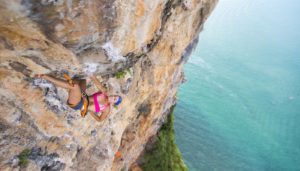
Introducing the First Climbing Emoji
It’s about time we had emojicons for climbers! For the past year, I’ve been working on creating one.
have wanted a climber emoji for a few years now. Admittedly, I love using emojis in my text messages and captions on social media. You can tell a lot about a person by their most frequently used emojis: how they interact with people, their sense of humor, how their mind works. For instance, these are my top emojis:

While there seems to be an emoji for all kinds of sports and outdoor activities, like surfing and weight lifting, there shockingly hadn’t been one for one of the fastest-growing adventure sports—until today! I first tweeted about the lack of a climbing emoji last May, tagging @GetEmoji, to highlight the absence. To my surprise, the account actually tweeted me back and said that I could submit an emoji design. I direct-messaged back, excited.
After an initial back-and-forth that I had with @GetEmoji, Jeremy Burge, the chief emoji officer of EmojiPedia, the clearinghouse for all emojis, contacted me directly. Jeremy is also a member of the Unicode Emoji Subcommittee, the group that manages the approval list for new emojis. Apple, Google, and Microsoft are all member companies, meaning that the emojis that Unicode supports are essentially universally available. Anyone can submit a proposal for a new emoji to Unicode, which then selects which new icons will make it to our keyboards. This counsel was a part of the movement two years ago to diversify emojis, which led to the inclusion of five more skin color options for human emoji characters as well as 32 more country flags and same-sex parent icons.
Jeremy and I communicated about what it would require to get a climber emoji. We talked about the potential popularity of a female climber emoji, image distinctiveness, and whether it completes any existing set of athlete emojicons. I sent Jeremy several photo examples of me scaling a rock face to use as source material. Since each symbol is so small—especially on mobile devices—you need to keep the visual simple. From the initial picture, we exchanged ideas, like ideal colors for the climber, the rock, and which type of shoes, and then Jeremy and a designer at Unicode drew up some sketches based off of the photos and insight.
sasha-climbing-emoji-process-sketch_h.jpg
(Javipec (L); Courtesy of Emojipedia (R))
We added the idea to an emoji candidate list managed by Unicode. At least once a year, Unicode releases a list of emojis which are approved for future release across computing platforms, which typically occurs with operating system updates. “Apple generally saves its major emoji updates for October or November each year,” Jeremy says. “So an emoji on the list published in the first half of 2017,” like the climber emoji, “would be expected to appear on phones by the end of the year.”
For a large part of my life I have needed to vigorously explain what climbing is to people outside of the insular community. To now have a climber emoji as part of the phone vernacular is emblematic of the surging popularity of the sport. “Having an emoji could be seen as a sign of legitimacy for many sports, as the burden of proof for adding a new emoji is quite high,” Jeremy says. “When a new emoji is approved by Unicode, that means that the case has been made for it being sufficiently popular—and also visually distinct. In the case of the climber emoji, there wasn’t any emoji that could be used as a reasonable substitute, which also helps the case.”
Now I have an accurate emoji to use when I describe what I am doing. I hope that other climbers will find this emoji appealing to use. There will be 12 variations on the way, including skin tones and genders, so there will be a climber emoji for everyone.

Tags: emoji






